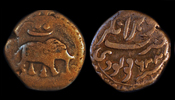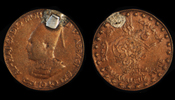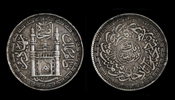|
|
India was ruled by two administrative systems by the British Government. About 60% of Indian subcontinent was under the Category of Provinces and 40% were Princely States.
Provinces were comprised of territories completely under British control, Princely States were states in British India with local ruler or King with honorary titles like Maharaja, Raja, Maharana, Rana, Nizam, Badshah etc., these rulers were subjected to British Government.
Until 1947/48 there were around 650 Princely States, these had their own separate coinage. The Princely States with abundant coinage were Hyderabad, Jaipur, Kutch and Travancore.
Awadh was ruled by Nawab � Wazirs on behalf of Mughal Emperor. Ghaziuddin was crowned in 1819, despite his proclamation of independence the first coin issues continued in the name of Mughal Emperor, with the Awadh Coat of arms on the reverse. Nasiruddin Hyder, Muhammad Ali and Wajid Ali succeeded Ghaziuddin. The monetary system consisted of gold Ashrafi; (half, quarter, eighth and sixteenth of an ashrafi), the silver rupee with similar fine denominations and the copper fulus.
The silver rupee minted by Nawab Amjad Ali Shah has a fish above which royal crown is shown. Two swords are around the crown and royal canopy.
The Kingdom of Mysore, situated in southwest India was ruled by various Hindu dynasties. In 1761 (1750-1779 AD), Hyder Ali, a military man took up the administration under his control. In this region, coins of both the Mughal and Vijayanagar standards were current. His coin issues coins of the iconographic forms of Vijayanagar period (Hara-Gauri) with his initial, the letter on the reverse. Tipu, his son (1750-1799 AD), after succeeding him assumed the title of Sultan Tipu minted very interesting coins, mostly with elephant on obverse. His most popular coin is �double rupee�. He introduced various innovations and varieties in his coinage, continuing with pagodas, the mohurs, and introduced his own standards. His coin did not bear his name. In 1799 he was slain by Britishers.
Later Hindu rulers of Mysore continued Hara-Gauri motif and King�s name on reverse. Some of the coins carried the image of deity Chamunda, and other carry the motifs of nature and inscriptions in Nagri, Persian, Kannada, and English.
In the Princely State of Hyderabad, the coins of Nizams were issued in the name of Mughal Emperor till 1858 when a coin legend was introduced with the name of the founder of the state, Asaf Jha. Afterwards, they were struck independently and termed as �Hali Sicca� i.e. the current sicca. In 1903-04 the coins were struck for the first time. These coins had charminar on the obverse with Persian inscription Nizamul Mulk Bahadur Asaf Jah around it, the value at reverse, having denominations and metal as that of British coins. |
|
|



